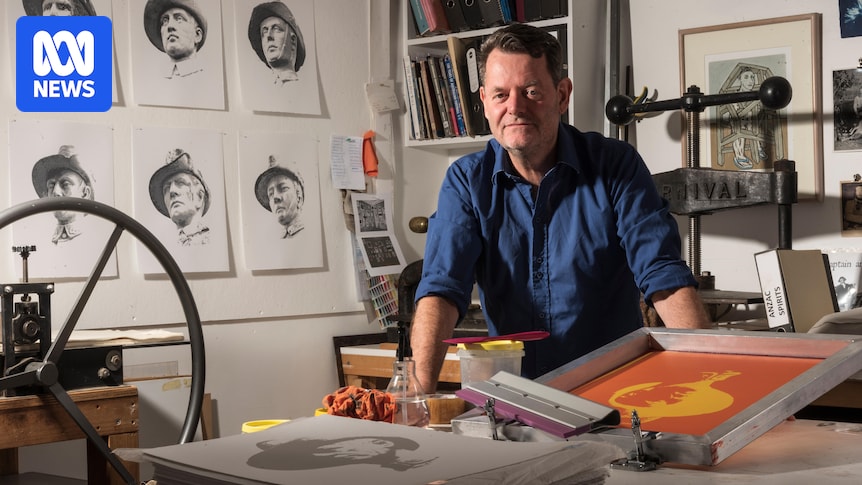Memorials to Victoria’s World War I diggers have become something of an obsession for Clayton Tremlett.
The Castlemaine-based artist with a background in art conservation has spent the past six years travelling across Victoria, documenting the craftsmanship and condition of more than 60 memorials erected to honour fallen servicemen and women from each district.
Murtoa’s World War I memorial was unveiled in 1920. (Supplied: Murtoa and District Historical Society)
“Many of the memorials, over the 100 years or so since they were dedicated, have taken on what would appear to be war injuries, in that they have chipped noses or missing ears, or a crack somewhere across the face,” Mr Tremlett told ABC Victorian Statewide Mornings.
The artist’s initial interest in these memorials started on trips “taking his son to play soccer in far-flung places across the state”, and soon developed into an extensively researched, contemporary art project.
The Immortals screen print portraits focus on the human face of Victoria’s war memorials, like this one in Nhill. (Supplied: Clayton Tremlett)
It involved taking photographs, usually at dawn, often on a very high ladder or via a drone, to capture the human faces depicted in marble or stone.
“I’m there at sunrise to catch the light on the face because [a lot of the figures face the East], and the slouch hats often float downwards,” he said.
“So, I’m trying to get the best light and a soft light.”
After taking about 80 photos of each memorial, he then chose the best image and used a process, including Photoshop, to produce screen print portraits on paper.
Immortals features screen print portraits of more than 60 WWI memorials from regional Victoria. (Supplied: Shrine of Remembrance)
The resulting exhibition, Immortals, is currently on display at the Melbourne Shrine of Remembrance.
Spotlighting regional war memorials
The centrepiece, along with the 66 screen print portraits, is a decommissioned memorial that once stood in the tiny community of Korong Vale, 230 kilometres north-west of Melbourne.
It is on loan from the Wedderburn and Korong Vale RSL.
“What I’m attempting to do is ask people to look at the faces of the memorials as a document of how the Anzac spirit was memorialised, but then look a little further into the human side of each of those figures,” Mr Tremlett said.
A decommissioned WWI memorial from Korong Vale is part of the Immortals exhibition. (Supplied: Shrine of Remembrance)
President of the Wedderburn and Korong Vale RSL, Roger Paterson, said the decommissioned statue spent quite a few years with a Castlemaine stonemason after using it as a reference for the replacement statue that was installed in 2017.
The original Korong Vale memorial was moved from the T-intersection of the main street to nearby Borella Park after being hit by a vehicle, causing it to snap at the legs.
“Around 2011, it was noticed that the statue was damaged again, and it’s conjecture whether it was deliberate or otherwise, but the hands and the rifle were missing,” Mr Paterson said.
Nicknamed “Jack” when the Immortals exhibition was shown at Bendigo’s Military Museum last year, Mr Paterson said the RSL was happy to see it included in the exhibition.
“We certainly don’t claim ownership; we’re just the custodians,” he said.
“But he wasn’t going back to the stonemason’s yard.”
The art and craft of memorialising the fallen
The exhibition also highlights the work of sculptor August Reitman, a pacifist of Swiss-German heritage, who significantly contributed to the image of the quintessential Aussie digger.
Mr Tremlett said he attributed at least 15 monuments to Reitman, who carved ears in a particular way and added a small patch with an “A” on his work.
“He probably carved about a quarter [of the statues] by himself, which is a remarkable effort over a 10-year period,” he said.
While the majority of the memorials are marble and imported from Italy, made by Italian craftspeople, Mr Tremlett said his favourite was one that stood atop an arch made from Australian sandstone in Murtoa, 25 minutes’ drive north-east of Horsham.
Murtoa’s war memorial is just one of those featured in an exhibition at the Shrine of Remembrance in Melbourne. (Supplied: Clayton Tremlett)
“A lot of memorials have had rifles smashed — some due to protest and some due to footballs being kicked in the main street,” Mr Tremlett said.
“[This one] had a replacement rifle made of fibreglass, painted khaki green, and it’s been painted so many times that it’s got a whole new life to it, a whole new character.”
Mr Tremlett said the memorials were still incredibly important for regional communities that were changed forever by that war.
The unveiling of Nhill’s WWI monument in 1921. (Supplied: Nhill and District Historical Society)
“Nhill’s memorial has around 300 names on it … none of those soldiers and nurses came back, during or after the First World War.”
The population of that western Victorian town pre-WW1 was about 900.
“A little community like Mitiamo has virtually nothing there now, or Ultima, it’s just a crossroad today, but these were once thriving wheatbelt towns, so that change over time inspired me to do further research,” Mr Tremlett said.
The exhibition combines history, art, community, and conflict in the context of Victoria’s digger memorials. (Supplied: Shrine of Remembrance)
Immortals is on display at Melbourne’s Shrine of Remembrance until April 13, 2025.
“Immortals provides a window to our nation’s history through the lens of regional memorials,” Shrine of Remembrance chief executive Dean Lee said.
“Clayton Tremlett’s dedicated work brings new light to the remarkable statues that quietly honour those who served.”
